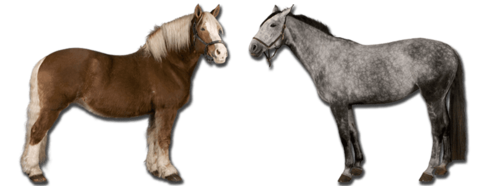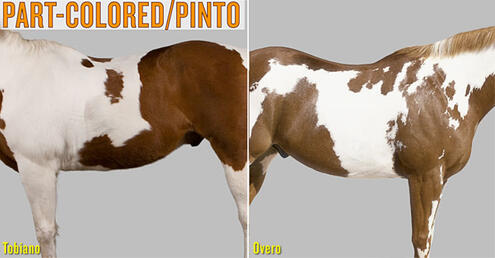All About Horses
Horse Breeds
Appaloosa, Belgian Draft, Holsteiner, Quarter Horse ... These are just a few of the over 200 different horse breeds living around the world today.
Although breeds can look wildly different, they all belong to a single species: Equus caballus.
Over thousands of years, people created different breeds by mating horses that have desirable traits. That's why the look of a breed is often related to what it's used for. When these traits get passed down over many generations, a new breed is produced.
For example, about 200 years ago, English horse breeders mated light, swift Arabians with local riding horses. This created the Thoroughbred–a lean, leggy, super-speedy breed used in horse racing.
Horse Coat Colors

Horses come in a wide range of colors and patterns. For some horse breeds , only a particular color or color combination is allowed. In others, individual horses may be virtually any color.
The coat color of a horse is determined by its genes. There are two basic coat colors: "red" & "black," which are associated with major genes . However, many other genes affect the final appearance of the horse. The mixing of these genes results in the rainbow of colors and patterns we see in horse breeds today.
How Do You Measure a Horse's Height?

Horses are measured from the ground to the top of the withers. The withers is the highest point of the back. It is created by the vertebrae between the shoulder blades.
Traditionally, horses are measured in "hands." One horse hand (or hh) is 4 inches long (10 centimeters). It's about the width of a man's fist. So 1 1/4 hands is written 1.1 hands, while 1 3/4 hands is written 1.3 hands.
One of the tallest breeds, the Shire, can reach 19 hands high (76 inches, or 193 centimeters). Miniature horses can be as small as 5 hands high (20 inches, or 51 centimeters).
Horses Come in 3 Basic Body Types

*hh = horse hands
Ponies
Ponies are usually small in size and stocky looking. They have been developed for use in specific environments. The depth of their body is usually equal to the length of their legs. In many equestrian competitions, any horse under 14.2 hands high (58 inches, or 147 centimeters) is considered a pony.
Ponies weigh from 200 to 1,500 pounds (91 to 680 kilograms).
Light Breeds
Light horses are bred for riding, racing, jumping, and herding. Their long, thin legs are designed for speed. Long, flexible necks help them stay balanced while running and maneuvering. Well-defined withers allow light horses to be easily fitted with a saddle.
Light breeds generally weigh from 800 to 1,500 pounds (363 to 680 kilograms).
Heavy breeds
Heavy breeds–also called draft horses–are big, massive horses. They are built to pull plows and wagons, and to carry hefty loads. Their relatively short, sturdy legs give them better leverage when pulling. Short, muscular backs and powerful hindquarters allow them to tow substantial weights.
Heavy breeds weigh from 1,400 to 2,700 pounds (635 to 1,225 kilograms).
Image Credits:
All images © AMNH.




 Biodiversity
Biodiversity
 Brain
Brain
 Genetics
Genetics
 Marine BiOLogy
Marine BiOLogy
 MicrobiOLogy
MicrobiOLogy
 PaleontOLogy
PaleontOLogy
 ZoOLogy
ZoOLogy
 AnthropOLogy
AnthropOLogy
 ArchaeOLogy
ArchaeOLogy
 Astronomy
Astronomy
 Climate Change
Climate Change
 Earth
Earth
 Physics
Physics
 Water
Water





















